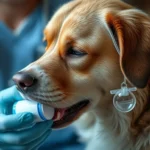
Introduction
Dental health is a crucial aspect of overall pet care that often gets overlooked. Recent studies reveal that over 80% of dogs exhibit some form of dental disease by the age of three. Regular dental cleanings are essential to prevent serious health issues, such as periodontal disease, which can lead to tooth loss and other systemic health problems.
The purpose of this article is to address the concerns many pet owners have regarding the safety of anesthesia during dental procedures. By providing evidence-based information, we aim to help you make informed decisions about your dog’s dental health.
Understanding Anesthesia in Dogs
What is Anesthesia?
Anesthesia refers to the use of medications that induce a state of controlled unconsciousness, allowing for pain-free surgical and dental procedures. In veterinary medicine, anesthesia is primarily used to ensure that animals remain still and comfortable during procedures that may cause discomfort or pain.
Types of Anesthesia Used in Veterinary Dentistry
There are two main types of anesthesia used during dental cleanings in dogs:
-
Local Anesthesia: This type numbs a specific area of the mouth, allowing for procedures like extractions or minor adjustments without affecting the entire body. Local anesthesia is generally used for less invasive dental work.
-
General Anesthesia: This is the more common choice for routine dental cleanings, as it renders the dog completely unconscious and relaxed. General anesthesia is necessary for thorough cleaning and examination of the teeth and gums.
How Anesthesia Works
In dogs, anesthesia works by blocking the brain’s pain pathways and inducing a state of unconsciousness. The veterinarian, along with trained veterinary technicians, monitors vital signs such as heart rate, respiratory rate, and blood pressure throughout the procedure to ensure safety.
The Need for Teeth Cleaning in Dogs
Common Dental Issues in Dogs
Dogs often suffer from various dental issues, including:
-
Plaque and Tartar Buildup: If left unchecked, plaque can harden into tartar, leading to gum inflammation and infection.
-
Periodontal Disease: This is a severe condition that affects the tissues supporting the teeth and can lead to tooth loss if not treated.
-
Other Dental Conditions: These can include fractures, abscesses, and malocclusions, which may require veterinary intervention.
Signs Your Dog May Need Dental Cleaning
As a responsible pet owner, it’s vital to recognize the signs that your dog may need dental cleaning. Look for:
-
Bad Breath (Halitosis): Persistent bad breath can indicate underlying dental issues.
-
Changes in Eating Habits: If your dog is reluctant to eat or chews only on one side of the mouth, it could be a sign of dental pain.
-
Visible Tartar or Gingivitis: If you notice brownish deposits on the teeth or redness and swelling in the gums, it’s time for a dental check-up.
Evaluating the Safety of Anesthesia
Factors That Influence Anesthesia Safety
When considering whether it is safe to put a dog under anesthesia for teeth cleaning, several factors come into play:
-
Dog’s Age and Health Status: Older dogs or those with underlying health conditions may face higher risks during anesthesia.
-
Breed-Specific Considerations: Certain breeds may have anatomical differences that affect anesthesia safety. For example, brachycephalic breeds like Bulldogs and Pugs are at higher risk for respiratory complications.
-
Pre-existing Medical Conditions: Dogs with heart, liver, or kidney issues may require special precautions.
Pre-Anesthetic Evaluation
A thorough pre-anesthetic evaluation is crucial for ensuring your dog’s safety. This includes:
-
Physical Examination: Your veterinarian will assess your dog’s overall health and any specific concerns.
-
Blood Tests and Health Screenings: These tests help identify any hidden health problems that could complicate anesthesia.
Anesthesia Risks and Complications
While anesthesia is considered safe when administered correctly, there are risks involved, such as:
-
Respiratory Complications: Dogs may experience difficulty breathing during or after anesthesia.
-
Cardiac Issues: Anesthesia can affect heart rate and rhythm, especially in dogs with existing heart conditions.
Veterinarians take numerous precautions to mitigate these risks, including careful monitoring and tailored anesthesia protocols based on your dog’s health status.
The Anesthesia Process for Dental Cleaning
What to Expect Before the Procedure
Before the dental cleaning, your veterinarian will provide specific instructions for preparing your dog for anesthesia. This may include:
-
Pre-Surgical Instructions: You may be advised to limit food and water intake prior to the procedure.
-
Fasting Requirements: Typically, dogs should fast for at least 12 hours before anesthesia to reduce the risk of vomiting during the procedure.
During the Procedure
During the dental cleaning, you can expect the following:
-
Monitoring and Safety Measures: Your dog will be monitored closely throughout the procedure. This includes continuous checking of heart rate, oxygen levels, and blood pressure.
-
Duration of the Procedure: Most dental cleanings under anesthesia last between 30 minutes to an hour, depending on the extent of cleaning required.
Post-Anesthesia Recovery
After the procedure, your dog will need time to recover. Key signs of recovery include:
-
Gradual Awakening: Your dog may appear drowsy and disoriented as they wake up from anesthesia.
-
Post-Operative Care: Follow your veterinarian’s aftercare instructions, which may include pain management and dietary recommendations. Monitor your dog for any signs of complications, such as excessive drooling or difficulty eating.
Alternatives to Anesthesia for Dental Care
Non-Anesthetic Dental Cleanings
Some pet owners may consider non-anesthetic dental cleaning options. These procedures involve scaling and polishing the teeth while the dog is awake, but they come with pros and cons:
-
Pros: No risks associated with anesthesia; quicker recovery time.
-
Cons: Limited effectiveness; the dog may not tolerate the procedure well; some dental issues may go undiagnosed.
At-Home Dental Care Practices
Maintaining your dog’s dental health at home is essential. Here are some effective practices:
-
Regular Brushing: Aim to brush your dog’s teeth daily or several times a week using dog-specific toothpaste.
-
Dental Chews and Toys: Provide dental chews and toys that help reduce plaque and tartar buildup.
-
Professional Dental Products: Consider using water additives and dental wipes designed for dogs.
Making an Informed Decision
Consulting with Your Veterinarian
It’s crucial to have open discussions with your veterinarian about your concerns regarding anesthesia and dental cleaning. They can provide insights tailored to your dog’s specific health needs. Here are some questions you might consider asking:
- What is the anesthesia protocol for my dog?
- What pre-anesthetic evaluations will be done?
- How will my dog be monitored during and after the procedure?
Balancing Risks and Benefits
When weighing the necessity of dental cleaning against the risks associated with anesthesia, consider the following:
- The potential consequences of untreated dental disease, such as pain, tooth loss, and systemic health issues.
- The overall health of your dog and how it may influence the risk of anesthesia.
Making the best choice for your dog’s health involves understanding both the risks and the benefits of dental cleanings under anesthesia.
Conclusion
In summary, dental health is a vital component of your dog’s overall well-being. While many pet owners express concern about the safety of anesthesia, when properly managed, it is generally safe. Regular dental cleanings performed under anesthesia can prevent serious health issues down the road.
Prioritizing your dog’s dental care, including routine check-ups and cleanings, is essential for their health and happiness. If you have any reservations or questions, don’t hesitate to discuss them with your veterinarian. Your dog’s smile—and overall health—will thank you!
This comprehensive article provides valuable insights into the safety of putting a dog under anesthesia for teeth cleaning while ensuring it remains informative and engaging for pet owners.









